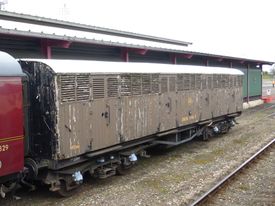GWR 2926 Siphon G Bogie Milk Van
| GWR 2926 Siphon G Bogie Milk Van | |
|---|---|
 GWR 'Siphon G' bogie gangwayed milk van 2926 | |
| Built By | Swindon |
| Status | Operational |
| Number | 2926 |
| Other Numbers | US7009, 7009 |
| History | |
| Built | 1940 |
| Diagram | O33 |
| Lot | 11651 |
| Type | Bogie Milk Van (NPCCS) |
| Telegraphic code | SIPHON G |
| 1985 | Arrived on SVR |
Contents
2926 in service
2926 was built at Swindon in 1940 as part of Lot 1651 to Diagram O33, for use by the United States Army Medical Corps. It was later converted for CasEvac Train use, and as US7009 was allocated to US Ambulance Train No 70 (as vehicle 7009) in 1943.[2] CasEvac is a military term for the emergency patient evacuation of casualties from a combat zone using non-specialised vehicles which may or may not provide patient care in transit, in contrast to MedEvac which uses standardised dedicated vehicles to provide patient care en route.[3]
Post World War 2 these ex-military Siphon Gs returned to their original intended role as express Milk Vans, although as milk churn traffic was replaced by road transport they were redeployed on Newspaper traffic until the 1980s.
2926 in preservation
2926 arrived on the SVR from Swindon on 29 March 1985, having been privately purchased by Mike Walker.[4][1] The owner commenced restoration shortly after arrival, and incorporated some parts from condemned Collett brake composite 6912 which 2926 was intended to replace. With restoration still not quite complete, 2926 was used as the exhibition vehicle for the Dedication Ceremony of LMS 8F 48773 as a memorial to British Military Railwaymen which took place on 27 September 1986. The restoration was finally completed the following month.[5]
2926 was used at Arley as a mobile store for Santa duties until 2018, with alternative Christmas services arrangements brought in from 2019. It is normally stored at Kidderminster at other times. Sadly, owner Mike Walker died on 14 January 2023.